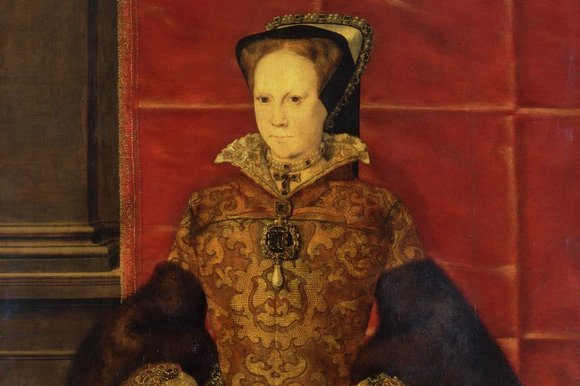
Between 1526 and 1539 an outstanding pearl entered the jewellery collection of the Empress Isabella of Portugal (1503-1539). Either it was a diplomatic gift or the Empress purchased it. When she died in 1539 the pearl was inherited by her daughter, Juana of Austria (1535-1573). Following a short marriage to Prince John of Portugal (1537 – 1554), Juana returned to Spain to assume regency for her brother, Philip II. Thus the pearl became part of Philip’s dowry for his new bride, Mary Tudor (1516-1558), after whom the pearl has been christened.
It is an outstanding asymmetrical drop-shaped pearl that was much admired by the Tudor courts and is featured in at least three Royal portraits of Mary Tudor, namely one by Anthonis Mor currently at the Prado, one by Hans Eworth in the National Portrait Gallery and a third owned by owned by the Society of Antiquaries.
Since the pearl’s disappearance in the late 16th century the pearls depicted in these portraits have – it is claimed now – mistakenly been identified as La Peregrina, a different pearl which is 53.57 grains smaller than the Mary Tudor pearl. However, Mary Tudor could never have worn the Peregrina as it was first recorded in 1579, 21 years after her death. However, in 2004 – what is presumed to be the real Tudor Pearl -surfaced at an auction and was bought by the select Jewellers Symbolic & Chase . This year it will be exhibited at the Antiques fair, Masterpiece London. The fair will take place from 27 June – 3 July 2012 (with a Preview on Wednesday 26 June) in the South Grounds of The Royal Hospital Chelsea, London SW3. The exhibition of the pearl is accompanied by a certificate from the Swiss Gemmological Institute stating that the pear weighs 64.5 carats (258.12 grains) and measures 16.50 -17.80 x 31.95 mm and is of natural saltwater origin. The Mary Tudor Pearl is the third largest well-formed pearl documented today.

Following its debut at Masterpiece London, the Tudor Pearl will be exhibited at the V&A as part of the Pearls exhibition, which will run from 21st September 2013 to 19th January 2014.

Continuing with the Queen Mary I theme, Philip Mould will be exhibiting a recently discovered English School portrait of Queen Mary I at the Fair. In the presentation of the portrait at his website it says that the new portrait is taken from the “larger portrait by Antonis Mor” in Prado. Curiously enough, however, Mary Tudor in the new portrait is not showing off her pearl but another magnificent jewel with three pearls hanging on her neck.
Provenance
Whether or not the “new” pearl is in fact the one presented to Queen Mary or whether – as is generally believed – it was the peregrina awaits to be seen. For one thing, Symbolic and Chase has not so-far published anything about the provenance apart from the tidbit, that it surfaced on an auction in 2004. As opposed to this the provenance of the Peregrina is well documented. After the death of Mary Tudor the pearl reverted to Spain and became part of the Spanish Crown Jewels, as is documented by a number of later paintings of Spanish Queens. Later, when Napoleons brother left Spain in 1813 he brought the peregrina with him. His nephew, the later emperor Napoleon III, sold it during his English exile to the Hamiltons, who put it up for sale at Sotheby’s in 1969, where Richard Burton bought it for Liz Taylor.
